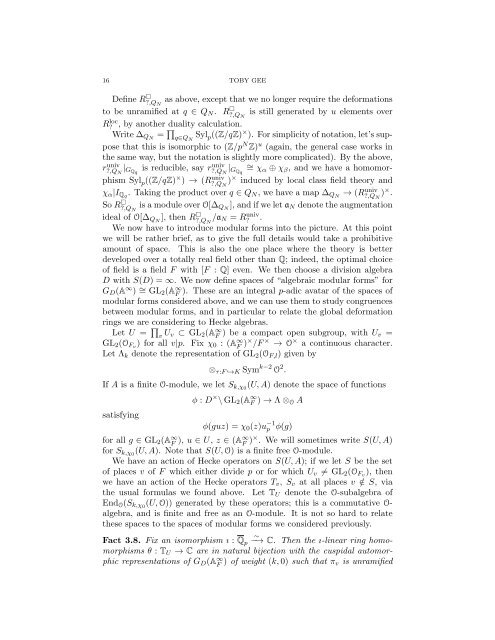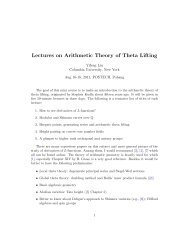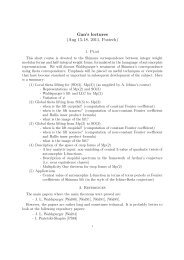MODULARITY LIFTING THEOREMS - NOTES FOR POSTECH ...
MODULARITY LIFTING THEOREMS - NOTES FOR POSTECH ...
MODULARITY LIFTING THEOREMS - NOTES FOR POSTECH ...
Create successful ePaper yourself
Turn your PDF publications into a flip-book with our unique Google optimized e-Paper software.
16 TOBY GEE<br />
Define R� as above, except that we no longer require the deformations<br />
?,QN<br />
to be unramified at q ∈ QN. R� is still generated by u elements over<br />
?,QN<br />
Rloc ? , by another duality calculation.<br />
�<br />
Write ∆QN = q∈QN Sylp((Z/qZ) × ). For simplicity of notation, let’s suppose<br />
that this is isomorphic to (Z/pNZ) u (again, the general case works in<br />
the same way, but the notation is slightly more complicated). By the above,<br />
∼= χα ⊕ χβ, and we have a homomor-<br />
runiv |GQq is reducible, say runiv<br />
?,QN ?,QN |GQq<br />
phism Sylp((Z/qZ) × ) → (Runiv ?,QN )× induced by local class field theory and<br />
χα|IQq . Taking the product over q ∈ QN, we have a map ∆QN → (Runiv<br />
?,QN )× .<br />
So R� ?,QN is a module over O[∆QN ], and if we let aN denote the augmentation<br />
ideal of O[∆QN ], then R� ?,QN /aN = Runiv ? .<br />
We now have to introduce modular forms into the picture. At this point<br />
we will be rather brief, as to give the full details would take a prohibitive<br />
amount of space. This is also the one place where the theory is better<br />
developed over a totally real field other than Q; indeed, the optimal choice<br />
of field is a field F with [F : Q] even. We then choose a division algebra<br />
D with S(D) = ∞. We now define spaces of “algebraic modular forms” for<br />
GD(A∞ ) ∼ = GL2(A∞ F ). These are an integral p-adic avatar of the spaces of<br />
modular forms considered above, and we can use them to study congruences<br />
between modular forms, and in particular to relate the global deformation<br />
rings we are considering to Hecke algebras.<br />
Let U = �<br />
v Uv ⊂ GL2(A∞ F ) be a compact open subgroup, with Uv =<br />
GL2(OFv) for all v|p. Fix χ0 : (A∞ F )× /F × → O × a continuous character.<br />
Let Λk denote the representation of GL2(OF,l) given by<br />
⊗τ:F ↩→K Sym k−2 O 2 .<br />
If A is a finite O-module, we let Sk,χ0 (U, A) denote the space of functions<br />
satisfying<br />
φ : D × \ GL2(A ∞ F ) → Λ ⊗O A<br />
φ(guz) = χ0(z)u −1<br />
p φ(g)<br />
for all g ∈ GL2(A∞ F ), u ∈ U, z ∈ (A∞ F )× . We will sometimes write S(U, A)<br />
for Sk,χ0 (U, A). Note that S(U, O) is a finite free O-module.<br />
We have an action of Hecke operators on S(U, A); if we let S be the set<br />
of places v of F which either divide p or for which Uv �= GL2(OFv), then<br />
we have an action of the Hecke operators Tv, Sv at all places v /∈ S, via<br />
the usual formulas we found above. Let TU denote the O-subalgebra of<br />
EndO(Sk,χ0 (U, O)) generated by these operators; this is a commutative Oalgebra,<br />
and is finite and free as an O-module. It is not so hard to relate<br />
these spaces to the spaces of modular forms we considered previously.<br />
∼<br />
Fact 3.8. Fix an isomorphism ı : Qp −→ C. Then the ı-linear ring homomorphisms<br />
θ : TU → C are in natural bijection with the cuspidal automorphic<br />
representations of GD(A∞ F ) of weight (k, 0) such that πv is unramified




